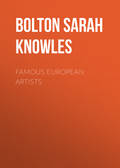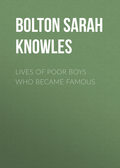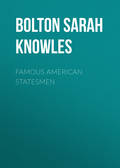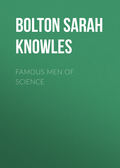
Bolton Sarah Knowles
Famous Givers and Their Gifts
"Toots," an old black and tan whom young Leland had brought from Albany, was much beloved. "Mr. Stanford would not allow a dog in the house save this one," says a writer in the San Francisco Chronicle. "'Toots' was an exception, and he had full run of the house. He was the envy of all the dogs, even of the noble old Great Dane. 'Toots' would climb upon the sofa alongside of Mr. Stanford, and forgetting a well-known repugnance he would pet him and say, 'There is always a place for you; always a place for you.'"
The year following the death of young Leland, on Nov. 14, 1885, Mr. Stanford and his wife founded and endowed their great University at Palo Alto. In conveying the estates to the trustees, Mr. Stanford said, "Since the idea of establishing an institution of this kind for the benefit of mankind came directly and largely from our son and only child, Leland, and in the belief that had he been spared to advise us as to the disposition of our estate he would have desired the devotion of a large portion thereof to this purpose, we will that for all time to come the institution hereby founded shall bear his name, and shall be known as the 'Leland Stanford, Jr., University.'"
Mr. Stanford and his wife visited various institutions of learning throughout the country, and found consolation in raising this noble monument to a noble son – infinitely to be preferred to shafts or statues of marble and bronze.
This same year, 1885, Mr. Stanford's friends, fearing the effect of his sorrow, and hoping to divert him somewhat from it, secured his election by the California Legislature to the United States Senate. He took his seat March 4, 1885, just a year after the death of his son. He did not make many speeches, but he proved a very useful member from his good sense and counsel and kindly leaning toward all helpful legislation for the poor and the unfortunate. He was re-elected March 3, 1891, for a second term of six years.
He will be most remembered in Congress for his Land-Loan Bill which he originated and presented to the Senate. "The bill proposed that money should be issued upon land to half the amount of its value, and for such loan the government was to receive an annual interest of two per cent per annum."
"Whatever may be thought by some of the practical utility of his financial scheme," says Mr. Mitchell, a senator from Oregon, "which he so earnestly and ably advocated, and which was approved by millions of his countrymen, for the loaning of money by the United States direct to the people at a low rate of interest, taking mortgages on farms as security, all will now agree it indicated in unmistakable terms a philanthropic spirit, an earnest desire to aid, through the instrumentality of what he regarded as constitutional and proper governmental influence, not the great moneyed institutions of the country, not the vast corporations of the land, with several of which he was prominently identified in a business way, but rather the great masses of producers, – the farmers, the planters, and the wage-workers of his country."
In this connection the suggestion of Professor Richard T. Ely in his book on "Socialism and Social Reform," page 334, might well be heeded. After showing that Germany and other countries have used government credit to some extent in behalf of the farming community, and that New York State has been making loans to farmers for a generation or more, he says, "A sensible demand on the part of farmers' organizations would be that Congress should appoint a commission of experts to investigate thoroughly the use of government credit in various countries and at different times, in behalf of the individual citizen, especially the farmer, and to make a full and complete report, in order that anything which is done should be based upon the lessons to be derived from actual experience."
Mr. and Mrs. Stanford were much beloved in Washington for their cordiality and generosity. They gave an annual dinner to the Senate pages, with a gift for each boy of a gold scarf-pin, or something attractive, and at Christmas a five-dollar gold-piece to each. Also a luncheon each winter, and gifts of money, gloves, etc., to the telegraph and messenger boys. Every orphan asylum and charity hospital in Washington was remembered at Christmas. Mr. Sibley, representative for Pennsylvania, relates this incident showing Mr. Stanford's habit of giving. "My partner and myself had purchased a young colt of him, for which we paid him $12,500. He took out his check-book, drew two checks of $6,250 each, and sent them to two different city homes for friendless children; and with a twinkle in his eye, and broadly beaming benevolence in his features, said, 'Electric Bell ought to make a great horse; he starts in making so many people happy in the very beginning of his life.'"
Mr. Daniels of Virginia tells how Mr. Stanford was observed one day by a friend to give $2,000 to an inventor who was trying to apply an electric motor to the sewing-machine. Mr. Stanford remarked, "This is the thirtieth man to whom I have given a like sum to develop that idea."
After Mr. Stanford had been in the Senate two years, on May 14, 1887, he and Mrs. Stanford laid the corner-stone of their University at Palo Alto, on the 19th anniversary of the birthday of Leland Stanford, Jr. In less than four years, on October 1, 1891, the doors of the University were opened to receive five hundred students, young men and women; for Mr. Stanford had written in his grant of endowment "to afford equal facilities and give equal advantages in the University to both sexes." In his address to the trustees he said, "The rights of one sex, political or otherwise, are the same as those of the other sex, and this equality of rights ought to be fully recognized."
Mrs. Stanford said to Mrs. White as they sat in her library at Palo Alto, "Whatever the boys have, the girls have as well. We mean that the girls of our country shall have a fair chance. There shall be no dividing line in the studies. If a girl desires to become an electrician, she shall have the opportunity, and that opportunity shall be the same as the young men's. If she wishes to study mechanics, she may do it."
Mr. Stanford said in his address on the day of opening, "I speak for Mrs. Stanford as well as for myself, for she has been my active and sympathetic coadjutor, and is co-grantor with me in the endowment and establishment of this University."
They had been urged to give their fortune in other directions, as some persons believed that much education would unfit people for labor. "We do not believe," said Mr. Stanford, and the world honors him for his belief, "there can be superfluous education. As man cannot have too much health and intelligence, so he cannot be too highly educated. Whether in the discharge of responsible or humble duties he will ever find the knowledge he has acquired through education, not only of practical assistance to him, but a factor in his personal happiness, and a joy forever."
Mr. Stanford desired that the students should "not only be scholars, but have a sound practical idea of commonplace, every-day matters, a self-reliance that will fit them, in case of emergency, to earn their own livelihood in an humble as well as an exalted sphere." To this end he provided, besides the usual studies in colleges, for "mechanical institutes, laboratories, etc." There are departments of civil engineering, mechanical engineering, electrical engineering, besides shorthand and typewriting, agriculture, and other practical work.
He wished to have taught in the University "the right and advantages of association and co-operation. … Laws should be formed to protect and develop co-operative associations. Laws with this object in view will furnish to the poor man complete protection against the monopoly of the rich; and such laws, properly administered and availed of, will insure to the workers of the country the full fruits of their industry and enterprise."
He gave directions that "no drinking saloons shall be opened upon any part of the premises." He "prohibited sectarian instruction," but wished "to have taught in the University the immortality of the soul, the existence of an all-wise and benevolent Creator, and that obedience to His laws is the highest duty of man." Mr. Stanford said, "It seems to us that the welfare of man on earth depends on the belief in immortality, and that the advantages of every good act and the disadvantages of every evil one follow man from this life into the next, there attaching to him as certainly as individuality is maintained."
The object of the University is, he said, "to qualify students for personal success and direct usefulness in life." Again he said, "The object is not alone to give the student a technical education, fitting him for a successful business life, but it is also to instil into his mind an appreciation of the blessings of this government, a reverence for its institutions, and a love for God and humanity."
Mr. Stanford wished plain and substantial buildings, "built as needed and no faster," urging the trustees to bear in mind "that extensive and expensive buildings do not make a university; that it depends for its success rather upon the character and attainments of its faculty."
Mr. Stanford chose for the president of his University David Starr Jordan, well-known for his scientific work and his various books. Though a comparatively young man, being forty years of age, Dr. Jordan had had wide experience. He was graduated from Cornell University in 1872, and for two years was professor at institutions in Illinois and Wisconsin. In 1874 he was lecturer in marine botany at the Anderson School at Penikese, and the following year at the Harvard Summer School at Cumberland Gap. During the next four years, while holding the chair of biology in Butler University, Indianapolis, he was the naturalist of two geological surveys in Indiana and Ohio. For six years he was professor of zoölogy in Indiana University, and for the six years following its president. For fourteen years he had been assistant to the United States Fish Commission, exploring many of our rivers, and part of that time agent for the United States Census Bureau in investigating the marine industries of the Pacific Coast. He had studied also in the large museums abroad.
Dr. Albert Shaw tells this interesting incident. "President Jordan had once met the young Stanford boy on the seashore, and won the lad's gratitude by telling him of shells and submarine life. It was a singular coincidence that the parents afterwards heard Dr. Jordan make allusions in a public address which gave them the knowledge that this was the interesting stranger who had taught their son so much, and had so enkindled the boy's enthusiasm. His choice as president was an eminently wise one."
Mr. Stanford wished ten acres to be set aside "as a place of burial and of last rest on earth for the bodies of the grantors and of their son, Leland Stanford, Jr., and, as the board may direct, for the bodies of such other persons who may have been connected with the University."
Mr. Stanford lived to see his University opened and doing successful work. The plan of its buildings, suggested by the old Spanish Missions of California, was originally that of Richardson, the noted architect of Boston; but as he died before it was completed, the work was done by his successors, Shepley, Rutan, & Coolidge.
The plan contemplates a number of quadrangles in the midst of 8,400 acres. "The central group of buildings will constitute two quadrangles, one entirely surrounding the other," says the University Register for 1894 – 1895. "Of these the inner quadrangle, with the exception of the chapel, is now completed. Its twelve one-story buildings are connected by a continuous open arcade, facing a paved court 586 feet long by 246 feet wide, or three and a quarter acres. The buildings are of a buff sandstone, somewhat varied in color. The stone-work is of broken ashlar, with rough rock face, and the roofs are covered with red tile." Within the quadrangle are several circular beds of semi-tropical trees and plants.
Miss Milicent W. Shinn, in the Overland Monthly for October, 1891, says, "I should think it hard to say too much of the simple dignity, the calm influence on mind and mood, of the great, bright court, the deep arcade with its long vista of columns and arches, the heavy walls, the unchanging stone surfaces. They seemed to me like the rock walls of nature; they drew me back, and made me homesick for them when I had gone away."
Behind the central quadrangle are the shops, foundry, and boiler-house. On the east side is Encina Hall, a dormitory for 315 men, provided with electric lights, steam heat, and bathrooms on each floor. It is four stories high, and, like the quadrangle, of buff Almaden sandstone.
On the west side of the quadrangle is Roble Hall, for one hundred young women, and is built of concrete. There are two gymnasiums, called Encina and Roble gymnasiums.
Perhaps the most interesting of all the buildings, the especial gift of Mrs. Stanford, is the Leland Stanford Junior Museum, of concrete, in Greek style of architecture, 313 by 156 feet, including wings, situated a quarter of a mile from the quadrangle, and between the University and the Stanford residence. The collection made by young Leland is placed here, and his own arrangement reproduced. The collection includes Egyptian bronzes, Greek and Roman glass and statues. The Cesnola collection contains five thousand pieces of Greek and Roman pottery and glass. The Egyptian collection, made by Brugsch Bey, Curator of the Gizeh Museum, for Mrs. Stanford, comprises casts of statuary, mummies, scarabees, etc. Mr. Timothy Hopkins of San Francisco, one of the trustees, has given for the Egyptian collection embroideries dating from the sixth to the twenty-first dynasty. He has also given a collection of ancient and modern coins and costumes, household goods, etc., from Corea. There are stone implements from Copenhagen, Denmark, and relics from the mounds of America. Mrs. Stanford is making the collection of fine arts, and a very large number of copies of great paintings is intended. Much attention will be given to local history, Indian antiquities, and Spanish settlements of early California.
The library has 23,000 volumes and 6,000 pamphlets. Mr. Hopkins has given a valuable collection of railway books, unusually rich in the early history of railways in Europe and America, with generous provision for its increase. Mr. Hopkins has also founded the Hopkins Seaside Laboratory at Pacific Grove, two miles west of Monterey, to provide for investigations in marine biology, as a branch of the biological work of the University.
Students are not received into the University under sixteen years of age, and if special students, not under twenty, and must present certificates of good moral character. If from other colleges they must bring letters of honorable dismissal. They are offered a choice of twenty-two subjects for entrance examination, and must pass in twelve subjects. Tuition in all departments is free.
"The degree of Bachelor of Arts is granted to students who have satisfactorily completed the equivalent of four years' work of 15 hours of lecture or recitation weekly, or a total of 120 hours, and who have also satisfied the requirements in major and minor subjects."
President Jordan says, in the Educational Review for June, 1892: "In the arrangement of the courses of study two ideas are prominent: first, that every student who shall complete a course in the University must be thoroughly trained in some line of work. His education must have as its central axis an accurate and full knowledge of something. The second is that the degree to be received is wholly a subordinate matter, and that no student should be compelled to turn out of his way in order to secure it. The elective system is subjected to a single check. In order to prevent undue scattering, the student is required to select the work in general of some one professor as major subject or specialty, and to pursue this subject or line of subjects as far as the professor in charge may deem it wise or expedient. In order that all courses and all departments may be placed on exactly the same level, the degree of Bachelor of Arts is given in all alike for the equivalent of the four years' course. Should his major subject, for instance, be Greek, then the title is given that of Bachelor of Arts in Greek; should the major subject be chemistry, Bachelor of Arts in chemistry, and so on."
In 1895 there were 1,100 students in the University, of whom 728 were men, and 372 women. Several of the students are from the New England States.
Mr. Stanford spent over a million dollars in the University buildings, and gave as an endowment over 89,000 acres of land valued at more than five million dollars. The Palo Alto estate has 8,400 acres; the Vina estate, 59,000 acres, with over 4,000 acres planted to grapes which are made into wine – those of us who are total abstainers regret such use; and the Gridley estate 22,000 acres, one of California's great wheat farms. In years to come it is hoped that these properties, which are never to be sold, will so increase in value that they will be worth several times five millions.
Mr. and Mrs. Stanford made their wills, giving to the University "additional property," that the endowment, as Mr. Stanford said, "will be ample to establish and maintain a university of the highest grade." It has been stated, frequently, that the "full endowment" in land and money will be $20,000,000 or more.
Senator Stanford's death came suddenly at the last, at Palo Alto, Tuesday, June 20-21, 1893. He had not been well for some time; but Tuesday he had driven about the estate, with his usual interest and good cheer. He retired to rest about ten o'clock; and at midnight his wife, who occupied an adjoining apartment, heard a movement as if Mr. Stanford were making an effort to rise. She spoke to him, but received no answer. His breathing was unnatural; and in a few minutes he passed away, apparently without pain.
Mr. Stanford was buried at Palo Alto, Saturday, June 24. The body lay in the library of his home, in a black cloth-covered casket, with these words on the silver plate: —
LELAND STANFORD
BORN TO MORTALITY MARCH 9, 1824
PASSED TO IMMORTALITY, JUNE 21, 1893
AGED 69 YRS., 3 MOS., 12 DAYS
Flowers filled every part of the library. The Union League Club sent a floral piece representing the Stars and Stripes worked in red and white in "everlasting," with star lilies on a ground of violets. There was a triple arch of white and pink flowers representing the central arch of the main University building. There were wreaths and crosses and a broken wheel of carnations, hollyhocks, violets, white peas, and ferns.
At half-past one, after all the employees had taken their last look of the man who had always been their friend, – one, seventy-six years old, who had worked with Mr. Stanford in the mine, broke down completely, – the body was borne to the quadrangle of the University by eight of the oldest engineers in point of service on the Southern Pacific Railroad. The funeral cortège passed through a double line of the two hundred or more employees at Palo Alto, several Chinese laborers being at the end of the line. Senator Stanford was always opposed to any legislation against the Chinese.
The body was placed on a platform at one end of the quadrangle, the remaining space being filled with several thousand persons. About sixteen hundred chairs were provided, but these could accommodate only a small portion of those present. The platform was decorated with ferns, smilax, white sweet peas, and thousands of St. Joseph's lilies. The temporary chancel was flanked by two remarkable flower pieces: on the left, a fac-simile of the first locomotive ever purchased and operated on the Central Pacific Railroad, the "Governor Stanford," sent by the employees of the company. The boiler and smoke-stack were of mauve-colored sweet peas; the headlight and bell were of yellow pansies; the cab of white sweet peas bordered by yellow pansies; the tender of white sweet peas edged by pansies and lined with ivy; on the side of the cab, in heliotrope, the name Governor Stanford. On the right of the bier was the gift of the employees of the Palo Alto stock-farm, a representation in sweet peas of the senator's favorite bay horse.
After the burial service of the Episcopal Church, a solo, "O sweet and blessed country," and address by Dr. Horatio Stebbins of the First Unitarian Church of San Francisco, the choir sang "Lead Kindly Light," and the body of Senator Stanford was conveyed through the cypress avenue to the mausoleum in the ten acres adjoining the residence grounds. The tomb is in the form of a Greek temple lined with white marble, guarded by a sphinx on either side of the entrance.
Here beside the open doors stood another beautiful floral tribute, a shield eight feet high, of roses, lilies, and other flowers sent by the employees of the Sacramento Railroad shops. Worked in violets were the words "The Laborers' Tribute to the Laborers' Friend." The choir sang, "Abide with Me," the body was laid in the tomb, and the bronze doors were closed. A few days later the body of Leland Stanford, Junior, the boy whose death, as Dr. Stebbins said at the senator's funeral, "drew the sunbeams out of the day," was laid beside that of his father. Some time the mother will sleep here with her precious dead.
Mr. Stanford's heart was bound up in his University. He said, after his son died, "The children of California shall be our children." Mr. Sibley of Pennsylvania tells how, three years after Leland Junior died, he and Mr. Stanford "went together to the tomb of the boy, and the father told amid tears and sobs how, since the death of his son, he had adopted and taken to his heart and love every friendless boy and girl in all the land, and that, so far as his means afforded, they should go to make the path of every such an one smoother and brighter."
Mr. Stanford told Dr. Stebbins, in speaking of the University: "We feel [he always used the plural, thus including that womanly heart from whose fountains his life had ever been refreshed] that we have good ground for hope. We are very happy in our work. We do not feel that we are making great sacrifices. We feel that we are working with and for the Almighty Providence."
By the will of Mr. Stanford the University receives two and a half million dollars, but this bequest is not yet available. He always felt, and rightly, that his wife owned all their large fortune equally with himself; therefore he placed no restrictions upon her disposal of it. Inasmuch as she is a co-founder of the University, she will doubtless add largely to its endowment. Should she do this, the power of Leland Stanford Junior University for good will be almost unlimited.
Even granite mausoleums crumble away; but great deeds last forever, and make their doers immortal.







